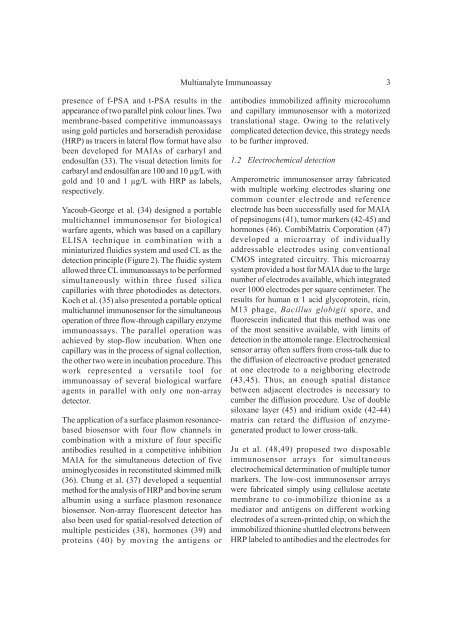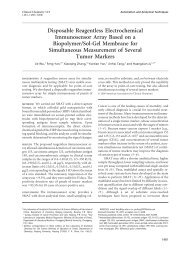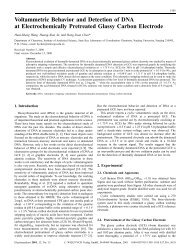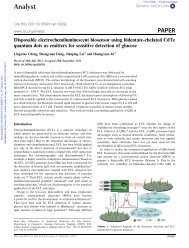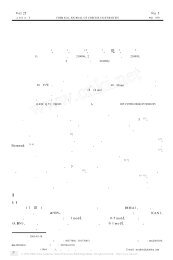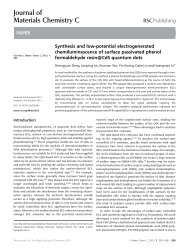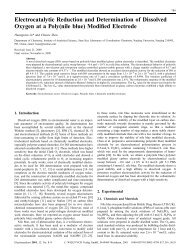Full paper
Full paper
Full paper
You also want an ePaper? Increase the reach of your titles
YUMPU automatically turns print PDFs into web optimized ePapers that Google loves.
Multianalyte Immunoassay 3<br />
presence of f-PSA and t-PSA results in the<br />
appearance of two parallel pink colour lines. Two<br />
membrane-based competitive immunoassays<br />
using gold particles and horseradish peroxidase<br />
(HRP) as tracers in lateral flow format have also<br />
been developed for MAIAs of carbaryl and<br />
endosulfan (33). The visual detection limits for<br />
carbaryl and endosulfan are 100 and 10 µg/L with<br />
gold and 10 and 1 µg/L with HRP as labels,<br />
respectively.<br />
Yacoub-George et al. (34) designed a portable<br />
multichannel immunosensor for biological<br />
warfare agents, which was based on a capillary<br />
ELISA technique in combination with a<br />
miniaturized fluidics system and used CL as the<br />
detection principle (Figure 2). The fluidic system<br />
allowed three CL immunoassays to be performed<br />
simultaneously within three fused silica<br />
capillaries with three photodiodes as detectors.<br />
Koch et al. (35) also presented a portable optical<br />
multichannel immunosensor for the simultaneous<br />
operation of three flow-through capillary enzyme<br />
immunoassays. The parallel operation was<br />
achieved by stop-flow incubation. When one<br />
capillary was in the process of signal collection,<br />
the other two were in incubation procedure. This<br />
work represented a versatile tool for<br />
immunoassay of several biological warfare<br />
agents in parallel with only one non-array<br />
detector.<br />
The application of a surface plasmon resonancebased<br />
biosensor with four flow channels in<br />
combination with a mixture of four specific<br />
antibodies resulted in a competitive inhibition<br />
MAIA for the simultaneous detection of five<br />
aminoglycosides in reconstituted skimmed milk<br />
(36). Chung et al. (37) developed a sequential<br />
method for the analysis of HRP and bovine serum<br />
albumin using a surface plasmon resonance<br />
biosensor. Non-array fluorescent detector has<br />
also been used for spatial-resolved detection of<br />
multiple pesticides (38), hormones (39) and<br />
proteins (40) by moving the antigens or<br />
antibodies immobilized affinity microcolumn<br />
and capillary immunosensor with a motorized<br />
translational stage. Owing to the relatively<br />
complicated detection device, this strategy needs<br />
to be further improved.<br />
1.2 Electrochemical detection<br />
Amperometric immunosensor array fabricated<br />
with multiple working electrodes sharing one<br />
common counter electrode and reference<br />
electrode has been successfully used for MAIA<br />
of pepsinogens (41), tumor markers (42-45) and<br />
hormones (46). CombiMatrix Corporation (47)<br />
developed a microarray of individually<br />
addressable electrodes using conventional<br />
CMOS integrated circuitry. This microarray<br />
system provided a host for MAIA due to the large<br />
number of electrodes available, which integrated<br />
over 1000 electrodes per square centimeter. The<br />
results for human α 1 acid glycoprotein, ricin,<br />
M13 phage, Bacillus globigii spore, and<br />
fluorescein indicated that this method was one<br />
of the most sensitive available, with limits of<br />
detection in the attomole range. Electrochemical<br />
sensor array often suffers from cross-talk due to<br />
the diffusion of electroactive product generated<br />
at one electrode to a neighboring electrode<br />
(43,45). Thus, an enough spatial distance<br />
between adjacent electrodes is necessary to<br />
cumber the diffusion procedure. Use of double<br />
siloxane layer (45) and iridium oxide (42-44)<br />
matrix can retard the diffusion of enzymegenerated<br />
product to lower cross-talk.<br />
Ju et al. (48,49) proposed two disposable<br />
immunosensor arrays for simultaneous<br />
electrochemical determination of multiple tumor<br />
markers. The low-cost immunosensor arrays<br />
were fabricated simply using cellulose acetate<br />
membrane to co-immobilize thionine as a<br />
mediator and antigens on different working<br />
electrodes of a screen-printed chip, on which the<br />
immobilized thionine shuttled electrons between<br />
HRP labeled to antibodies and the electrodes for


